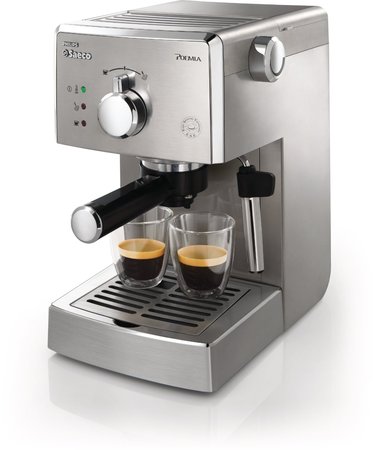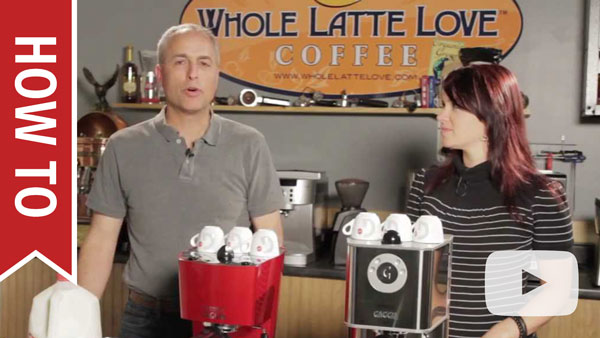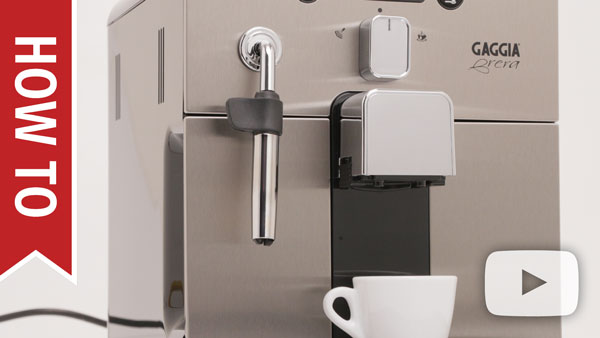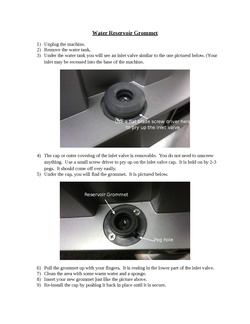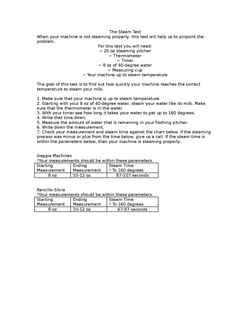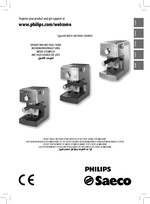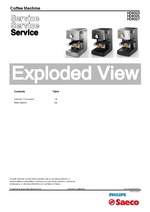Saeco Poemia
From Whole Latte Love Support Library
The Saeco Poemia is a semi-automatic espresso machine which has a simple design and features a pressurized brewing system.
| Saeco Poemia |
|---|
| Manufacturer: Saeco |
| Model Name: Poemia |
| Model Number: HD8327/47 |
| Type: Semi-Automatic |
Contents
[hide]- 1 Basic Usage
- 2 Cleaning & Maintenance
- 3 Troubleshooting
- 4 Diagrams & Manuals
- 5 Specifications
Basic Usage
Getting Started
Cleaning & Maintenance
Proper machine maintenance is critical to proper machine functionality. Most machine failures are caused by a lack of cleaning and maintenance. This is vital, as many manufacturer warranties do not cover cleaning/maintenance related breakdowns. To avoid this, it is imperative to keep a regular maintenance schedule. Listed below is a suggested maintenance rundown for most semi-automatic espresso machines:
Descaling
Descaling the machine should be done on a bimonthly basis using the product recommended by the manufacturer. Descaling is still required even if reverse osmosis, distilled, or zero water is being used. Refer to your machine manual for specific instructions for this unit.
Grouphead Cleaning
The grouphead should be taken apart on a monthly basis to remove scale buildup, remove coffee residues, and improve shot flavor.
Steam Wand Cleaning
Steam wands, steam tips, and nozzle attachments should be cleaned daily after the machine is finished being used for the day. Milk residues quickly build up on steam wands and frothing nozzles, so it is important to keep these clean to prevent blockages from forming.
Replacing Group Gasket
The group gasket will typically need to be replaced approximately every six months to a year. It is not necessary to replace the gasket until leaking at the grouphead occurs, but it is good to have a gasket on hand since the machine cannot be used with a broken gasket. Instructions can be found on page 25 of your user manual.
Recommended Cleaning Products
The compatible descaling products for this machine are Durgol Swiss Espresso Descaler or Saeco Descaler. The best product for cleaning metal grouphead components and filter baskets is a backflushing powder like Urnex Cafiza.
Troubleshooting
No Crema or Bad Tasting Shots
Bad tasting shots or shots with poor crema do not typically indicate an issue with the machine; rather it indicates that an adjustment needs to be made to the brewing technique or some other external factor.
The following articles review the different variables and offer solutions:
- Check to make sure the coffee is ground properly for espresso.
- Please note that tamping is not relevant to this machine, since this machine uses a pressurized portafilter.
- It is important to use fresh beans, typically beans roasted within the past two weeks are best. Light and medium roasts are best for espresso brewing and higher crema content. Storing beans properly is also important, more information can be found here.
- If the behavior persists after reviewing these factors then the machine may need to be cleaned. Lack of cleaning can cause burned or bitter flavors, or create flow issues which can result in a weak shot. Make sure the machine is properly cleaned and maintained to remove these flavors.
Difficulty Frothing
As with brewing, frothing is highly dependent on technique. If the machine is producing steam then an adjustment to technique may need to be made. Frothing is very sensitive to technique, so there is a steep learning curve. The video below shows proper frothing technique for pannarello style wands:
There are also common frothing mistakes which are made that will result in poor or no froth. The video below identifies these mistakes and shows how to correct them:
This machine also utilizes a special nozzle attachment called a pannarello. The pannarello nozzle needs to be regularly cleaned and properly attached to the machine in order to function. This machine uses a 3-piece style of pannarello instead of the normal 6-piece style. The video below describes how to properly clean and maintain this three piece style of wand:
Alternatively you can try frothing on the machine without the pannarello attachment. The naked wand can also produce a tight microfoam, and is preferred by some users. The major disadvantage of frothing with the naked wand is that it reduces the length of the steam wand by several inches.
Flow Issues
The first place to start with any flow issue is cleaning the machine. Before going through these steps please make sure the machine is cleaned according to the Cleaning & Maintenance section of this article.
No Steam From Wand
- Check the brew function on the machine and see if water is able to flow through the machine for this function.
- If the brew water is not flowing either refer to the No Flow At All section of this article
- If the brew water flows but is not hot refer to the On But Not Heating section of this article.
- Turn the hot water function on for the steam wand to test for flow.
- If nothing comes through refer to the Only Flow From Brew Head section of this article.
- If water does come through try setting the machine to steam mode again and testing for steam. Running the hot water function can help remove blockages in the steam wand assembly.
- Unplug the machine and remove the top to check for any loose or disconnected wires, and resecure these connections.
- If nothing else looks wrong then the steam thermostat has probably failed in will need to be replaced.
Only Flow From Steam Wand
Try these steps in the following order. Between each step test the machine for flow. If flow is restored to the machine do an immediate descale of the unit before returning to normal use.
- Test the flow of the machine without the portafilter attached. If the machine flows with the portafilter removed then one of the filter baskets is blocking the flow. Clean the baskets by soaking them in a solution of hot water and backflushing powder for 30 minutes, or boiling the baskets for 30 minutes.
- Make sure the grouphead is completely clean and free of debris. Be sure to completely disassemble the grouphead for cleaning.
- First remove the screw from the shower screen. The screen should be able to come off now, it may need to be gently pried loose if scale buildup is holding it in place.
- Soak the shower screen in a solution of hot water and backflushing powder.
- While the screen is soaking take a grouphead cleaning brush, or an old toothbrush, and use it to brush down the grouphead. Make sure to clean the gasket in particular, the gasket will not seal properly if there coffee grounds/residues built up on it.
- The groupvalve may be dirty or broken. While the grouphead is apart for cleaning the groupvalve should be cleaned as well. Once the group is apart you will be able to access the groupvalve; there will be a flat slit for a Philips head screwdriver. The group valve is listed as part 11 on p.4 of the parts diagram of the machine. Unscrew the groupvalve from the group assembly. Soak the metal valve assembly in a solution of hot water and backflushing powder. Also inspect the spring and the rubber stopper, listed as parts 12 & 13, to make sure they are in good condition.
Only Flow From Brew Head
Remove the pannarello nozzle from the steam wand and test the flow using the hot water function. If flow is restored then the pannarello needs to be cleaned and reattached. Otherwise, if the flow is still blocked then there may be a blockage in the steam wand itself. Clean the inside of the wand by inserting a pipe brush that has synthetic or plastic bristles; metal bristles can damage the wand. Then soak the wand in a solution of hot water and backflushing powder for ten minutes.
No Flow At All
If the machine is not outputting any water follow the instructions below. Once flow is restored make sure to pull a full 8 oz. of water using the hot water function to ensure the machine is correctly primed.
- Check the water tank to make sure it is filled to the max line.
- Remove the water tank, take it over to a sink, and press on the check valve at the bottom. There will be a plus sign shaped piece of plastic on the bottom of the water reservoir that you can press upwards. Water should pass through when you press up on the piece.
- Make sure the tank is seated properly. If the tank is not inserted all the way the check valve at the bottom of the water tank will not open to release water into the machine. Check to see if there are any coffee beans or any other possible debris preventing the tank from sitting flush into the machine.
- Activate the hot water function on the machine. You should hear a vibration noise coming from the machine to indicate that the pump is activated. Water should start coming through the wand after 15-20 seconds. If no water comes through turn the hot water function off.
- The pump of the machine may be vapor locked, requiring a force prime of the unit. The video below shows how to force prime this style of machine. The machine in the video is different, but the same process can be applied to this unit.
Machine Is Leaking
Between Portafilter & Grouphead
If the machine is leaking from between the grouphead and the portafilter then the grouphead gasket is either pushed out of place and needs to be reinserted properly, or the gasket is worn out. Typically grouphead gaskets will wear out from 6 months to a year depending on how heavily the machine is used. Premature wear to this gasket can be caused by using excessive force when attaching the portafilter, or leaving the machine on for long periods of time without use. Leaking from this area indicates that the group gasket will need to be replaced.
- To access the gasket the shower screen will need to come off first. Remove the screw in the center of the grouphead, listed as part 8 on p.4 of the machine's parts diagram.
- Once this screw is remove the screen will come off (part 9).
- The gasket is part 10. It will need to be gently pried out. The gasket can get stuck in the grouphead from wear or excessive heat exposure. To remove the gasket take some self-tapping screws and partially screw them into the group gasket. Make sure not to go all the way through the gasket because you can scratch/dent the grouphead if you go too far. Then use a pair of pliers to pull on the screws and the gasket will pull out with them.
- To install the new gasket simply press it into place firmly. Push all around the perimeter of the gasket to make sure it is fully inserted.
- Reassemble the grouphead. To help make sure the gasket is seated properly firmly place the portafilter on several times.
From Bottom Of Machine
- Check the water tank and drip tray to make sure that are no cracks or breaks where water can escape. Make sure they are properly positioned on the machine.
- The water tank needs to be seated securely on the machine. Make sure there isn't anything causing the water tank to sit crookedly. If the water tank isn't flush with the machine the check valve at the bottom of the tank will be open, but it won't seal with the inlet line. As a result the water tank chamber will flood with water and clear water will leak from the bottom of the machine.
- The water reservoir grommet is worn, dirty, or out of position. If this is the cause of the leak there will be water leaking between the tank and the base of the machine, which will run down the back of the machine and pool at the foot of the unit. The grommet can be accessed for cleaning and replacement by following these instructions:
- A replacement reservoir grommet can be purchased here.
- The pump is leaking. This requires a considerable amount of disassembly and should only be attempted by a service technician.
From Steam Wand
- If the wand is leaking from the end of the wand it means the steam valve is not fully closed.
- Try tightening the knob down firmly. Pressure from the boiler will leak through the wand if the steam valve is not securely closed.
- If it feels like the knob is spinning in place then the knob may be broken. Try removing the knob and manually turning the steam valve closed. An adjustable wrench or a pair of pliers can help with this. If this stops the leak then the steam knob will need to be replaced.
- Descale the machine according to the instructions in the Cleaning & Maintenance section above. Scale buildup inside of the steam valve will prevent the valve from closing fully and can cause permanent damage to the valve. After the machine has been descaled run 4-6 tanks of water through the wand using the machine's hot water function to ensure any debris or scale in the valve is fully removed.
- If the leaking persists then the steam valve will need to be replaced.
- If the wand is leaking from where it connects to the machine then the wand is not sealing properly to the steam valve assembly. Make sure the wand is properly secured to the steam valve assembly. If tightening the wand onto the steam valve assembly does not resolve the leaking issue then there may be a worn or broken o-ring.
Machine Not Heating Or Powering On
No Power
- Make sure the machine is plugged into an appropriate power source.
- Do not use the machine on a surge protector. This machine has a high power draw, more than a typical kitchen appliance such as a refrigerator or a microwave. Surge protectors are typically not rated to handle the amperage this machine requires.
- Try using the machine on a different outlet, and make sure the machine is the only appliance plugged into that outlet.
- Try testing another appliance on the same outlet.
- Unplug the machine and inspect the power cord for any damage such as nicks in the plastic or fraying.
- Turn the power button off and unplug the machine. Remove the top of the machine. Check the machine for any other loose, disconnected, or burned wires. Check the power switch terminals in particular.
- If the machine recently had a leak, had water spilled on it, or any other exposure to moisture then the machine may be shorting out. Try letting the machine sit unplugged for 48 hours to make sure there isn't a short caused by moisture.
Brew Not Heating
- Check to make sure the machine is set to heat for the brew function.
- Give the machine sufficient time to heat up. It can take up to ten minutes for this machine to be sufficiently heated for brewing. Make sure the portafilter is attached during heating.
- Make sure the brew indicator light has come on to indicate the machine is heated.
- While the water in the boiler may have heated to the correct temperature within minutes the grouphead may still be cold. If the grouphead is still cold then the temperature of the brew water will be drastically reduced once the water exits the boiler and comes into contact with other cooler components. This is why it is important to give the machine at least ten minutes to fully heat.
- If the water coming from the brew head is completely cold then the brew thermostat may need to be replaced. Test to see if the machine can he for the steam function. If it can then the brew thermostat should be replaced. Instructions for replacing the brew thermostat can be found here
Steam Not Heating
- First make sure that there isn't any sort of flow issue by looking at the section of this article that discusses steam wand blockages.
- Make sure the machine is set to steam mode, and that the indicator light says that the machine is heated for steam.
- It is normal to have water come through the steam function for the first 5-10 seconds of steaming. This happens because the hot steam condenses back into water after it leave the boiler and come into contact with the room temperature steam valve and wand assemblies. For this reason you should do a process called purging.
- To purge the steam wand place an empty cup under the steam wand and turn the steam knob to the open position.
- Let the steam come through for 5-10 seconds, until there is significantly less water and a strong jet of steam.
- Close the knob, and begin your normal frothing process.
- If the preceding steps have not resolved the issue then the steam thermostat will need to be replaced.
Pannarello Nozzle Not Staying Attached
If the pannarello nozzle attachment is not staying on the machine, or it keeps blowing off during steaming, then it is either not attached properly or is plugged with milk residues and needs to be cleaned. Please refer to the cleaning and attachment instructions covered in the frothing issues section of this article.
Portafilter Handle Not Fitting On Machine
- On new machines the portafilter will not fit perpendicular to the machine. This is because the grouphead gasket requires time to wear in before this can happen. As long as you can get the portafilter hand tight onto the machine and brew without leaking then the machine is operating properly. Do not use excessive force when attaching the portafilter or it can damage or break the grouphead gasket.
- Too much coffee may be dosed into the portafilter. If there is too much coffee in the portafilter is can press into the shower screen and prevent the portafilter from attaching properly. Reduce the amount of coffee in the portafilter or test the machine with an empty portafilter. If the portafilter attaches properly then the filter basket was simply overdosed.
- Check the filter baskets for dings, dents, or any sort of warping. A filter basket that is malformed can prevent the portafilter from attaching. Try attaching the portafilter with the basket removed, or with a different basket to see if it fits on correctly.
- The group gasket has slipped out of place or needs replacing. Please refer to the section of this article which discusses gasket issues for instructions on how to test the gasket or replace it.
- The grouphead may be damaged. If the machine was dropped or the grouphead was struck hard, then it can damage the grouphead. The grouphead would need to be replaced. This is not a normal occurrence and only happens if the machine has been mishandled.
Too Much Steam/Milk Boiling
If you think your wand is producing too much steam, or your milk looks like it is boiling, then you may need to make an adjustment to your frothing technique. Boiling milk, or milk that is getting to hot before frothing is completed is an indication that incorrect frothing technique is being used. Review the section of this article that addresses frothing difficulties for more information.
If you have tried adjusting your technique and the wand still appears to be producing too much steam, then a steam test should be completed.If the machine is within the specified steam test range, then the machine is producing the correct amount of steam and an adjustment to frothing technique is necessary. Using a carafe that is chilled in a freezer before frothing is helpful for keeping the milk cooler for longer, allowing for more time to froth before the milk begins to scald.
Diagrams & Manuals
| Saeco Poemia | |
|---|---|
| Electrical Diagram: | Not Available |
| Hydraulic Diagram: | Not Available |
| Machine Manual: | |
| Parts Diagram: | |
| Service Manual | Not Available |
| Startup Guide: | Not Available |
Specifications
| Basic Specs | |
|---|---|
| Width: | 7.8 in. |
| Height: | 11.69 in. |
| Depth: | 10.43 in. |
| Weight: | 8 lbs |
| Wattage: | 1060 |
| Voltage: | 110 |
| Housing | |
| Housing Materials: | Stainless Steel / Plastic |
| Drip Tray Material: | Plastic |
| Drip Tray Cover Material: | Stainless Steel
|
| Cup Height | |
| Max Cup Height: | 3.5 in. |
| Frothing | |
| Material: | Stainless Steel |
| Steam Wand Style: | Pannarello |
| Wand Movement: | Articulating |
| Usable Length: | 4.5 in. |
| Height Off Counter: | 2.75 in. |
| Number Of Holes: | 1 |
| Water Source | |
| Reservoir Or Plumbed: | Reservoir |
| Reservoir Capacity: | 60 oz. |
| Reservoir Material: | Plastic |
| Reservoir Removable: | Yes |
| Controls | |
| Type Of Controls: | Knob |
| Cup Warmer | |
| Size: | Stainless Steel |
| Passive / Active: | Passive |
| Portafilter Data | |
| Material: | Stainless Steel |
| Type: | Pressurized |
| Quantity Included: | 1
|
| Diameter: | 53 mm. |
| Commercial Filter Baskets Included: | No |
| Pressurized Filter Baskets Included: | Yes |
| Ground, E.S.E. Pod And Capsule Compatible: | Ground & ESE Pod |
| Bottomless Portafilter Available: | No |
| Tamper Size: | 53 mm. |
| Brew Group | |
| Material: | Aluminum |
| Preheat: | No
|
| Capsule/Pod Friendly: | Yes
|
| Boiler Data | |
| Number Of Boilers: | 1 |
| Brew Boiler Data | |
| Boiler Wattage: | 1050 |
| Boiler Voulme: | 9 oz. |
| Boiler Material: | Stainless Steel |
| Boiler Orientation: | Vertical |
| Element Location: | Internal |
| Pump Data | |
| Pump Type: | Vibration
|
| Max Pressure: | 15 Bar |
| Self Priming: | Yes |
| details | |
| Country Of Manufacture: | Italy |
| NSF Certified: | No |
| Recommended Application: | Home |
